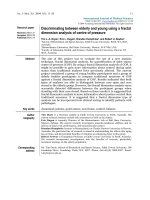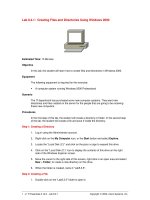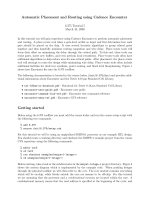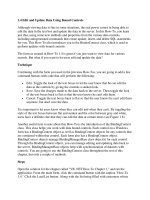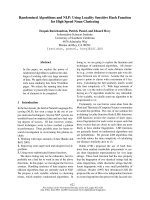Finace and investments using
Bạn đang xem bản rút gọn của tài liệu. Xem và tải ngay bản đầy đủ của tài liệu tại đây (3.83 MB, 347 trang )
Finance and
Investments Using
The Wall Street Journal
Peter R. Crabb, Ph.D.
Northwest Nazarene University
Boston Burr Ridge. IL Dubuque.IA Madison.WI NewYork San Francisco St. Louis
Bangkok Bogota Caracas KualaLumpur lisbon London Madrid MexicoCity
Milan Montreal New Delhi Santiago Seoul Singapore Sydney Taipei Toronto
FINANCE AND INVESTMENTS
Peter R. Crabb
USING THE WALL STREET JOURNAL
Published by McGraw-Hill/Irwin,
an imprint of The McGraw-Hill Companies, Inc., 1221 Avenue of the
Americas, New York, NY 10020. Copyright © 2003 by The McGraw-Hill Companies, Inc. All rights reserved.
No part of this publication may be reproduced or distributed in any form or by any means, or stored in a
database or retrieval system, without the prior written consent of The McGraw-Hill Companies, Inc., including,
but not limited to, in any network or other electronic storage or transmission, or broadcast for distance learning.
2 3 4 5 6 7 8 9 0 CUS/CUS 0 9 8 7 6 5 4 3
ISBN 0-07-282936-2
www.mhhe.com
Preface
For many years, finance professors have used The Wall Street Journal in their
classrooms. The Journal continuously provides opportunities to illustrate theories and
concepts put forth in finance textbooks and lectures. My students regularly evaluate
the use of The Wall Street Journal as one of their most valuable experiences in school.
This book is a formal adoption of this successful teaching methodology.
Finance and Investments Using The Wall Street Journal is, however, more than a
study guide. The chapters that follow lead the student through traditional textbook
material with real and current financial information. This book assists students with
their study of finance by providing exercises that go beyond hypothetical questions on
textbook theories, and by providing thought provoking questions for class discussion
from actual articles.
Each of the following chapters has the same general format. The chapter begins with
a list oflearning objectives and key terms, followed by the written material. This
presentation of the subject is not as comprehensive as that found in a general corporate
finance or investments text, but the material will help students understand the
important terms and concepts in finance. Throughout the chapter the student is asked
to complete questions to insure their understanding of these important terms and
concepts. Data for the questions are drawn from actual Journal articles, reports, and
tables and answers to these questions are included in the appendix.
Further exercises and discussion questions are found at the end of each chapter. The
student is asked to apply what they have learned by repeating some assignments from
the chapter using a current edition of The Wall Street Journal, and a final exercise
takes a more in depth look at the concepts presented in the chapter. Each chapter
concludes with an article or feature column from a previous Journal and a series of
questions for further thought and discussion in the student's study group or class
meeting.
To students, I hope you find your study of finance through this book to be both
interesting and rewarding. And to professors, I hope you find that using this approach
makes teaching finance and investments as interesting and rewarding as it has been for
me.
Acknowledgements: In all I do I give thanks to God; for from him and through him
and to him are all things (Romans 11:36). I am grateful for the love and support of my
111
wife and family during this project. My thanks to Brenda Johnson of Northwest
Nazarene University for assistance editing the text and to Cody Crail, an outstanding
NNU student, for assistance with the assignments, exercises, and discussion questions.
Finally, I am grateful to Michele Janicek and all of the McGraw-Hill staff for making
this project a success.
Peter R. Crabb, Ph.D.
Professor of Finance and Economics
School of Business and Economics
Northwest Nazarene University
IV
Table of Contents
PART I - INTRODUCTION
1. Finance and Investments
in The Wall Street Journal ....................................................... 3
PART II - ECONOMIC ANALYSIS
2. Eco n 0 mi c An al ysis ..............................................................................................................
19
3. In d ustry Analysis ................................................................................................................
39
4. International
59
Economics
and Markets ................ :............................................................
PART III - SECURITIES MARKETS ANALYSIS
5. Time Value of Money .........................................................................................................
81
6. Bond Val uations .................................................................................................................
97
7. Stock Val ua tions ...............................................................................................................
119
8. Fore ign E xc hang e ............................................................................................................
137
PART IV -INVESTMENT
9. Financial
10. Technical
Statement
ANALYSIS
Analysis ..........................................................................................
Analysis ..........................................................................................................
159
177
PART V - DERIVATIVE SECURITIES
11. 0p ti 0 ns ............................................................................................................................
203
12. Fut ures ............................................................................................................................
219
13. Index Fu tures and Opti ons ............................................................................................
239
PART VI - PORTFOLIO MANAGEMENT
14. Risk M easu re me n t ..........................................................................................................
v
261
15. Asset All oc ati 0 n ..............................................................................................................
279
16. Ben ch ma r ki n g ................................................................................................................
299
PART VII- CORPORATE FINANCING
17. Cost of Capital ...................................................................
·.... ·.......................................
319
18. Public Offering of Securities .........................................................................................
337
19. Dividend Policy ...............................................................................................................
353
20. Me rg ers and Acq uisi ti 0 ns ..............................................................................................
367
Appendix - Answers to Selected Assignments ....................................................................
383
VI
PART I
INTRODUCTION
Finance and Investments
Chapter 1
Finance and Investments in
The Wall Street Journal
Objectives
1. Describe the different types of financial markets reported on in the WSJ
2. Describe the different types of investments reported on in the WSJ
3. Learn how to quickly navigate the sections, pages, columns, tables, and charts of
financial information in the WSJ
Key Terms
Financial Markets
Financial Assets
Primary Market
Secondary Market
Money Markets
Capital Markets
Organized Exchange
Over-the-Counter (OTC)
Real assets
This chapter presents an overview of the WSJ, and the financial markets and
institutions on which the WSJ reports. Information from the WSJ is used here to describe
the types of financial markets that exist and the types of investments traded in these
financial markets. The chapter includes an exercise designed to help you learn where and
how to find information on finance and investments in the WSJ.
Financial Markets
Afinancial market is a market in which financial assets (securities), such as stocks
and bonds, can be purchased or sold. Afinancial asset is any contractual claim on an asset
or group of assets. For example, a stock is a contractual claim on the assets of a
corporation. A bond is also a legal contract in the form of a loan to a corporation. Financial
markets are means of financial intermediation - the transfer of financial savings from one
part of the economy, to investments in another part of the economy. Financial markets also
provide investors a means to manage risk.
3
Finance and Investments
There are three broad classifications of financial markets: primary versus secondary
markets, money versus capital markets, and organized versus over-the-counter markets. In
a primary market, new securities, such as stocks or bonds, are issued by corporations. This
market involves the exchange of funds for a financial claim. The financial claim may be
either debt or equity. Debt instruments or debt securities are contractual obligations of a
debtor (borrower) to a creditor (lender). A company that sells bonds is borrowing from the
purchaser of the bond. In a primary market sale of a bond the borrower receives cash, and
the lender receives a financial asset, the IOU. Equity securities or stocks are financial
claims for ownership rights in a corporation as well as grants of voting rights for the
management of the corporation. In a primary market sale of stock, the firm again receives
cash, but this time in exchange for ownership rights.
For example, on June 14,2002 the WSJ reported that Pacer International, Inc., a
truck and rail line shipper, sold 14 million shares of stock to the public on June 13 at $15
per share. This primary market transaction raised $210 million for the company in
exchange for ownership interests. News of primary market transactions are reported each
day in the WSJ. Articles discussing the offerings are most often found in the Money and
Investing section.
Previously issued debt or equity securities trade in the secondary market. When
stocks or bonds are sold between investors no new funds are created for the issuer of the
security - the corporation. Secondary markets serve an important function by providing
liquidity for sellers. The more liquid a financial assets (the more easily it can be bought and
sold) the less risk involved for the investor. When stock or bond markets are more liquid
there are lower costs associated with finding buyers. After their sale in the primary market,
all types of stocks and bonds trade in secondary markets.
The Pacer International Inc. stock discussed above began trading in the secondary
market on June 13,2002. Recall that the firm sold the shares at $15 each. On its first day
of trading, the stock price rose higher, and the last trade of the day was at $15.95 per share.
This secondary market activity in the stock is also found in the Money and Investing section
of the WSJ. The Money and Investing Section includes trading activity for major stock
transactions each business day.
Exercise 1-1
The following two headlines appeared in the WSJ on June 14,2002:
"Treasury Plans Sale of $32 Billion in Short- Term Bills"
"Wal-Mart, Target Slide on Gloomy Retail Data"
1. Which headline refers to primary market transactions?
2. Which headline refers to secondary market transactions?
4
Finance and Investments
Money and Capital Markets
The second classification for a financial market is a money or capital market. The
money market is a market where short-term investments, usually less than one year in
length, are traded. This market is a debt market only. Since stocks are a claim on the assets
of a corporation, and corporations are generally ongoing concerns, stocks represent longterm securities for the firm. The money market has only high quality issuers, including the
U.S. government and low risk corporations. That is, firms that borrow in the money market
are well-known companies with a strong history of meeting their obligations. The money
market is very liquid (high number of buyer and sellers), but since it is short-term in nature
it provides low returns on investment. The capital market on the other hand is long-term
(greater than one year), includes both stocks and bonds, and has a range of corporations
(low and high risk).
Each day the Money and Investing section of the WSJ includes a table entitled
Money Rates. The Money Rates table includes rates for commercial paper - a money
market security. Commercial paper is a short-term (less than 270 days) debt instrument
issued by well-established corporations. Commercial paper is often used by other corporate
financial managers wishing to earn interest on the cash flow from their business until it is
needed. The Money and Investing Section also includes the Credit Markets column. The
Credit Markets column covers both new (primary market) and existing (secondary market)
debt securities from the U.S. Government, state and local governments, and corporations.
Long-term U.S. Government securities are called Treasury notes and bonds. These capital
market transactions range from 1 to 10 years in maturity.
Exercise 1-2
Refer to the two headlines in Exercise 1-1.
1.
Which headline refers to money-market transactions?
2.
Which headline refers to capital market transactions?
Stock and Bond Exchanges
The third classification of financial markets is based on where the market activity,
buying and selling, takes place. In this respect, financial markets are either organized or
5
Finance and Investments
over-the-counter (OTC). An organized exchange for financial assets has a visible
marketplace, such as the New York Stock Exchange (NYSE) on Wall Street in New York
City. In this marketplace, members trade securities that are "listed" on the exchange. In
contrast, some markets for financial assets are traded by wired computer networks. These
over-the-counter markets are made-up of securities dealers, and have no central or physical
location. The National Association of Securities Dealers Automated Quotation System
(NASDAQ) is an OTC market for stocks.
The secondary market for bonds includes organized exchanges and an GTC market.
Most corporate bonds are traded in over-the-counter markets. However, many bonds from
large issuers are traded on the organized exchanges, such as the NYSE and the American
Stock Exchange (AMEX). The secondary market prices and current yields for these bonds
are found in the U.S. Exchange Bonds table of the Money and Investing section. Also, the
Markets Lineup column reports the closing value of the Dow Jones Bond Averages - an
index of corporate bonds.
6
Finance and Investments
Source: The Wall Street Journal, June 14, 2002. Reprinted by permission of Dow Jones &
Company, Inc. (c) 2002 Dow Jones & Company, Inc. All Rights Reserved Worldwide.
Use the above table which lists rates of exchange for the U.S. dollar relative to foreign
currencies to answer the following questions.
1. According to the text accompanying the table, where does trading in foreign
currencies occur?
7
Finance and Investments
2. According to the text accompanying the table, between what parties did this trading
occur?
3. Is this an over-the-counter or organized exchange?
Investments
Investors have many different opportunities in which to invest their funds.
Financial assets such as stocks and bonds can be held by investors in both direct and
indirect forms. Investors can buy and sell stocks and bonds directly through financial
markets, or indirectly by pooling their funds with other investors. Mutual funds are
investment vehicles that pool the money of many small investors and invest it in shares of
companies, bonds, or other assets. A mutual fund is a company itself, with a board of
directors that hires the fund's managers. A key advantage of mutual funds is that you can
invest small amounts and your money automatically buys a share in the in many different
companies. The Mutual Funds tables of the Money and Investing section include the
pricing and return information for thousands of stock and bond funds. The tables also
include a report called the Mutual-Fund Scorecard which tracks the best and worst
performing funds in a variety of different sectors.
Information on the investment value of financial assets is easily found in the WSJ
A good summary of financial market activity is the Markets Lineup page, found each day in
the WSJ on the second page of the Money and Investing section. This full page table
reports secondary market activity for stocks, bonds, and mutual funds. The Stocks section
of this table includes price changes in many different sectors of the U.S. financial markets.
The Interest Rates & Bonds portion of this table includes listings of interest rates for
corporate borrowers and a listing of Consumer Rates. Consumer rates include money
market accounts and certificates of deposits.
To this point our discussion has focused on the markets for financial assets, or
financial securities. These assets are only one type of investment. Other investment
opportunities exist in the market for real assets. Just like with financial assets, investors
seek capital gains or current income from real assets. A real asset is any tangible piece of
property - an item that can be seen and felt. Two common investment choices for real
assets are real estate and commodities, such as gold and diamonds. Investors can purchase
real estate (land, houses, office buildings, or apartments) either directly or indirectly. Real
estate can be purchased directly from the seller or investors can pool their money in real
estate funds. Similarly, investments in commodities can be bought directly, or indirectly
through stocks and mutual funds. Information is available in the WSJ for many types of
8
Finance and Investments
commodities and real estate. For example, the Futures tables found in the Money and
Investing section of the WSJ includes prices for gold coins such as the American Eagle.
Exercise 1-4
Finance and Investments
Source: The Wall Street Journal, June 25,2002. Reprinted by permission of Dow Jones &
Company, Inc. (c) 2002 Dow Jones & Company, Inc. All Rights Reserved Worldwide.
Use the above charts and tables from the WSJ to answer the following questions.
1.
What financial asset information is included in the Markets Diary report?
2.
What real asset information is included in the Markets Diary report?
10
Finance and Investments
Project 1-1
Repeat Exercises 1-1 and 1-2 using a recent edition of the WSJ.
1. Find a headline that refers to primary market transactions?
Date
2. Find a headline that refers to secondary market transactions?
Date
3. Find a headline that refers to money-market transactions?
Date
4. Find a headline that refers to capital market transactions?
Date
II
Finance and Investments
Project 1-2
To answer the questions below, review a recent copy of the WSJ. Take a look at each of the
first three sections - section A, or "First" section, section B, "Marketplace", and section C,
"Money and Investing".
You can also learn how to navigate the pages of the WSJby
taking an on-line tour. Go to . This web site will take you through each
of the three main sections of the newspaper. The topics discussed below can be found by
clicking on the section title and scrolling through the drop-down menu.
1. Under what heading and in what section of the WSJ will you find the latest news of
inflation, unemployment, and Federal Reserve policy?
2. Under what heading and in what section of the WSJ will you find reports that
describe trends, issues and legislation affecting small businesses?
3. Under what heading and in what section of the WSJ will you find the closing price
and net change for stocks traded in Canada or Africa?
4. Under what heading and in what section of the WSJ will you find announcements of
quarterly and annual financial figures from corporations?
5. Under what heading and in what section of the WSJ will you find a digest of the
latest news developments from around the world?
13
Finance and Investments
Discussion Questions
Number of Millionaires Rose
3% in 2001 Despite Downturn
By
JANE J. KIM
Dow Jones Newswires
NEW YORK-The number of millionaires last year grew the most in countries where they diversified their wealth
away from stocks, according to the World
Wealth Report relea~e~ by Merrill Lynch
& Co. and Cap GemInI Ernst & Young.
Despite the economic downturn, the
number of high net-worth individuals
world-wide-defined as those with financial assets of at least $1 million, excluding real estate-rose to 7.1 million in
2001,up 3%from the previous year. Meanwhile, their combined wealth edged
higher to $26.2trillion.
The 3%growth in 2001-roughly half of
the 6%growth recorded in 2000and a significant decline from the 18%gain in 1999-indicates that a "significant minority" of
high net-worth individuals remained
heavily invested in equities, especially
"growth" stocks, according to the report,
which published its first edition in 1997.
Slower economic growth and falling stock
markets were the strongest dampers on the
portfoliosof high net-worth investors.
Manyrich investors, however,were successful in expanding their worth. Besides
shifting away from stocks, those who were
successfulrebalanced their remaining equities away from technology and growth
stocks toward value and blue-chip names.
They also sought out alternative investments such as hedge funds and structured
products, and relied more heavily on help
from their financial advisers. Many high
net-worth individuals started moving their
money toward hard assets such as real estate, fixed income and alternative investments near the end of 2000, said Alvi
Abuaf, vice president, global financial services at Cap Gemini Ernst & Young.
Source: The Wall Street Journal, June 19, 2002. Reprinted by permission of Dow Jones &
Company, Inc. (c) 2002 Dow Jones & Company, Inc. All Rights Reserved Worldwide.
1.
According to the article, what did "successful" investors do in 2001?
2.
List and describe some of the financial assets mentioned in the article.
15
Finance and Investments
3.
List and describe some of the real assets mentioned in the article.
4.
What region of the world is most heavily invested in equities (stocks)? Why do you
think this is so?
16
PART II
ECONOMIC ANALYSIS
Economic Analysis
Chapter 2
Economic Analysis
Objectives
1. Describe the economic data regularly reported in the WSJ
2. Learn to use economic reports and economic principles to analyze financial
market activity
3. Understand how inflation effects financial markets and the economy.
4. Understand the government's role in the economy.
Key Terms
Gross Domestic Product (GDP)
Real GDP
Unemployment Rate
Leading Economic Indicators
Consumer Price Index (CPI)
Producer Price Index (PPI)
Monetary Policy
Federal Funds
Fiscal Policy
All companies are affected to some degree by the overall level of economic
activity. For this reason, investors and managers alike track the economy using
economic data available from both private and government sources. The WSJ reports
all the latest news on the economy and includes data for most economic releases. In
this chapter we will explore economic reports on inflation, unemployment, and
economic activity at all levels. This information is valuable when analyzing financial
markets. The ability to understand economic data also helps us to understand the
nature of the business cycle, the ebb and flow of economic activity, and the
government's role in the economy.
19
Economic Analysis
Economic Activity
Inside the first section of the WSJyou will find the Economy column. The
articles in this section of the paper cover all the latest news on economic activity,
including economic data reports and economic policies. With regard to economic
data, let's start at the top. The broadest measure of overall economic activity is gross
domestic product (GDP). GDP is the most closely watched of all economic variables
because it is arguably the best measure of society's income, or its well-being. Just as a
company is said to be 'doing well' if its net income is up, a society with a growing
GDP will be better off; consumers will have more to spend on goods and services.
When society is better off business activity improves, improving profits and raising
stock prices. GDP measures the market value of all the final goods and services
produced in the economy. Including only the final output avoids the measurement of
economic activity twice. For example, steel is used in the production of automobiles,
but the final purchase price of the automobile includes the cost of the component steel.
The U.S. Department of Commerce measures and releases quarterly estimates
of GDP, expressed at seasonally adjusted annual rates. The WSJ reports the latest
announcement of GDP data, and follows with any subsequent revisions to the data.
The first Department of Commerce report, released one month following the end of
the quarter, is an estimate that is frequently subject to revision when more data is
collect. The WSJ article on GDP announcements includes a statistical summary of the
data; breaking down the major components ofGDP - personal consumption (the
personal spending of consumers), investment (both residential and non-residential
investments by businesses and individuals), net exports (total exports - total imports),
and government purchases.
As an example, on April 29, 2002 the WSJ reported the most recent GDP
announcement - 5.8% annualized real GDP growth in the first quarter of2002. The
article points out that more than half this growth was due to business non-residential
investment. In the first quarter of the year businesses were primarily replenishing
inventories rather than producing for new sales. This is an addition to the second
component of GDP- investment. Investments in inventories, however, is not as
permanent as investments in new buildings or equipment; suggesting the strong
growth in GDP may be only temporary.
To measure the change in income for the economy without including the
impact of changing prices, GDP is reported on a constant-dollar, or real, basis. Real
GDP is the market value of all final output of goods and services using prices for a
given base year (currently 1996). Thus, the current output is calculated using the base
year prices as opposed to current prices. Since real GDP is not affected by changes in
prices, any change in its value reflects only changes in actual production. Currentdollar, or nominal, GDP reflects changes in production as well as prices. Nominal
GDP may increase or decrease simply because of changes in the selling price of
20
Economic Analysis
goods, and not because of any actual change in the quantity of goods and services
sold. To breakout this affect of prices, the U.S. Department of Commerce also
publishes a measure of the price level known as the implicit price deflator (IPD),
which is calculated as the ratio of current-dollar value to the corresponding constantdollar value, multiplied by 100. The annual rate of change in the IPD is included in
the summary report following the WSJ article on GDP.
When a society keeps its workers employed it will produce a higher level of
GDP than would be possible ifmany workers were without ajob. Therefore, another
good measure of the economy's well being is the percentage of its labor force that is
currently unemployed, or the unemployment rate. The unemployment rate is
calculated as the number of unemployed workers divided by the total labor force and
multiplied by 100. Every month the U.S. Department of Labor reports on the level of
unemployment and other labor statistics. These statistics are based on the Labor
Department's regular survey of thousands ofD.S. households. The WSJreports the
latest announcement of the unemployment rate and includes a statistical summary of
the data; breaking out some important demographics such as men and women, teenagers, and minority unemployment rates. Another important statistical release with
this report is the average weekly hours for the month. The number of regular hours
worked and the level of overtime work generally expand with an improving economy.
Real GDP and the unemployment rate are good measures of overall economic
activity, but they both lack one important feature that investors and business managers
need to make sound decisions. Each of these statistics is backward looking rather than
forward looking. Investors and managers need economic information that will help
them forecast business activity in the future. No economic indicator is going to be
100% accurate at predicting the future, but some indicators are likely to rise or fall in
advance of an economic upturn. Therefore, economists have created an index of
variables from a wide variety of economic activity that generally rises in advance of
an overall economic upturn. The index of leading economic indicators is compiled
by the Conference Board, a private research group, and is designed to predict
economic activity six to nine months in advance. A three to four month sustained
decline in the index consistently precedes a decline in overall economic activity
(GDP). The average weekly hours worked data, previously discussed as part of the
unemployment report, is one of the ten leading economic indicators. The other nine
are stock prices (500 common stocks), interest rate spread, index of consumer
expectations (survey), vendor performance (time to delivery), manufacturers' new
orders for consumer goods and materials, building permits, average weekly initial
claims for unemployment insurance (inverted), real money supply, and manufacturers'
new orders for non-defense capital goods. Note that average weekly initial claims for
unemployment insurance is inverted ( lover the average weekly initial claims) to
reflect its relation to economic growth - a decline in unemployment insurance claims
reflects an improving economy.
21
Economic Analysis
As an example, the Conference Board announced on April 18, 2002 that the
U.S. leading index increased by 0.1 percent in March, to 112.3 ( the base year being
1996, with a value of 100). For this reporting month, six of the ten indicators rose
while four declined. The gains in the index would have been larger if it had not been
for very weak levels of building permits and high claims for unemployment insurance.
The WSJ reported that this small change in the index suggests that the economy should
grow in the coming months, but the level of growth is likely to be small. It is
important to note that stock prices, probably the most accurate and reliable indicator of
future economic activity, were one of the six rising indicators in this report. This
presents a problem for investors using the leading index as a gauge of future stock
market activity - any future economic gains or loses may already be reflected in
current stock prices. For this reason, reports on the index of economic leading may
not be much help to investors trying to forecast future stock prices.
Exercise 2-1
Source: The Wall Street Journal, May 6,2002. Reprinted by permission of Dow Jones &
Company, Inc. (c) 2002 Dow Jones & Company, Inc. All Rights Reserved Worldwide.
Use the above summary table from the WSJ to answer the following questions.
1. Verify the current month's unemployment rate by dividing the number of
unemployed by the total work force?
22
Economic Analysis
2. Did the unemployment rate increase or decrease for the current month? Did
the number of unemployed rise? Did the size of the workforce increase or
decrease?
3. What was the change, if any, in the average weekly hours for all private, nonfarm workers? What does this change suggest for the economy?
Inflation
Equally important to a society's standard of living is a society's cost of living.
It is one thing to know the quantity of output in goods and services, but it is also
useful to measure changes in purchasing power. A rise in the overall level of prices in
the economy, or inflation, increases the cost of living for consumers. That is, inflation
reduces consumer purchasing power. rf consumer incomes fail to keep up with rising
prices, consumers will quickly become discouraged, buying less goods and services.
Therefore, financial markets and business managers closely monitor indicators of
inflation. Furthermore, if lenders believe future prices will be higher they will require
higher rates of interest on their loans; further discouraging consumers and businesses
that borrow.
The WSJ includes monthly reports on inflation at both the consumer and
wholesale level. The U.S. Department of Labor reports the Consumer Price Index
(CPI). The cpr is an inflation gauge that measures changes in the prices of consumer
goods- a list of specific goods and services purchased in urban areas. This list, or
"market basket" of goods, includes food, clothing, shelter, and other typical purchases,
each weighted by its relative importance to the monthly household budget. The list of
budget items in the cpr includes food, housing, and travel expenses. Because the way
consumers spend their income is constantly changing, the cpr basket of goods, and the
weights for each, are subject to revision. The Department of Labor has been criticized
in the past for not promptly making these revisions to reflect changing consumer
preferences. Current cpr announcements include any changes in the weights or other
aspects of the index.
The Department of Labor also reports price level activity at the wholesale
level. The Producer Price Index (PPI) is an index tracking commodities that won't
undergo further processing and are ready for sale to the ultimate user, but are sold at
the wholesale, not retail, level. The Department of Labor ppr report also includes a
23
